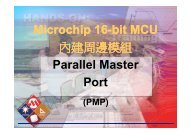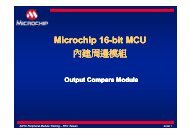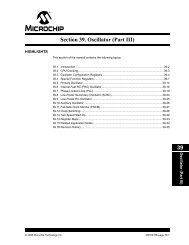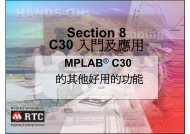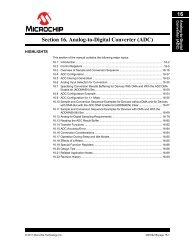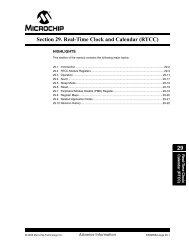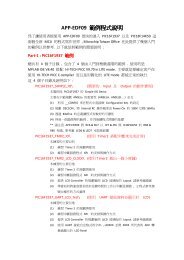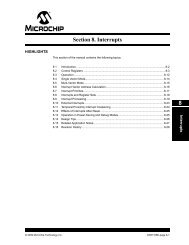Section 4. Program Memory - Microchip Taiwan
Section 4. Program Memory - Microchip Taiwan
Section 4. Program Memory - Microchip Taiwan
Create successful ePaper yourself
Turn your PDF publications into a flip-book with our unique Google optimized e-Paper software.
dsPIC33E/PIC24E Family Reference Manual<strong>4.</strong>4 PROGRAM MEMORY ACCESS USING TABLE INSTRUCTIONSThe TBLRDx and TBLWTx instructions offer a direct method of reading or writing the leastsignificant word (lsw) and the Most Significant Byte (MSB) of any address within program spacewithout going through data space, which is preferable for some applications.<strong>4.</strong><strong>4.</strong>1 Table Instruction SummaryA set of table instructions is provided to move byte- or word-sized data between program spaceand data space. The table read instructions are used to read from the program memory spaceinto data memory space. The table write instructions allow data memory to be written to theprogram memory space using write latches.Note:Detailed code examples using table write instructions can be found in <strong>Section</strong>5. “Flash <strong>Program</strong>ming” (DS70609).The four available table instructions are:• TBLRDL: Table Read Low• TBLWTL: Table Write Low• TBLRDH: Table Read High• TBLWTH: Table Write HighFor table instructions, program memory can be regarded as two 16-bit, word-wide addressspaces residing side by side, each with the same address range (as illustrated in Figure 4-3).This allows program space to be accessed as byte or aligned word addressable, 16-bit-wide,64-Kbyte pages (i.e., same as data space).TBLRDL and TBLWTL access the least significant data word of the program memory, and TBLRDHand TBLWTH access the upper word. Because program memory is only 24 bits wide, the upperbyte from this latter space does not exist, although it is addressable. It is, therefore, termed the“phantom” byte.Figure 4-3:High and Low Address Regions for Table OperationsPC Address0x0001000x0001020x0001040x00010623168000000000000000000000000000000000<strong>Program</strong> <strong>Memory</strong>‘Phantom’ Byte(Read as ‘0’)‘HIGH’ Table Address Range‘LOW’ Table Address RangeNote:The TBLPAG register can be written using the MOVPAG #lit8, TBLPAG instructionor the MOVPAGW Wn, TBLPAG instruction. Refer to the “16-bit MCU and DSC<strong>Program</strong>mer’s Reference Manual” (DS70157) for details.DS70613B-page 4-6© 2010 <strong>Microchip</strong> Technology Inc.




